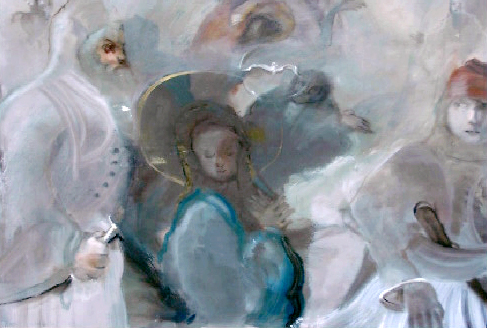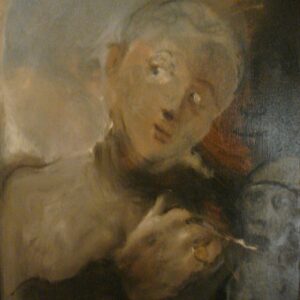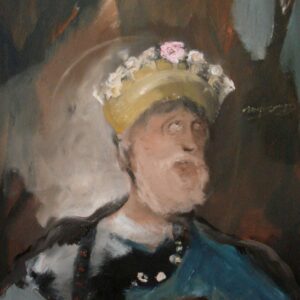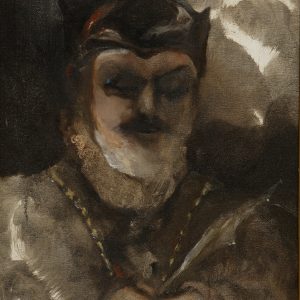Description
Artist/Maker: Kostas Kampouropoulos (1939-2018)
Object/Materials and Techniques: Oil on Canvas
Date: Painted between 2007-2016
Dimensions: H. 100 cm. x W. 120 cm.
Art style: Romantic Elements / Expressionistic Structures / Abstract Art
Current Location: Private collection
Curator’s note: A painting homage to the Hellenic War of Independence, known as the Struggle of Hellas against the Ottoman Empire, in the 19th century (between 1821-1830).
It refers to the Hellenic Revolution which, according to tradition, on 25 March 1821 was officially declared. This chronology is a brilliant calendar date for the Hellenic citizens and is celebrated by the modern Hellenic State as a National Day due to the fact that furthermore coincides with the religious feast of the Annunciation.
Capitalizing on strong allegory with a powerful accent, Kostas Kampouropoulos, in his own distinct way, addresses the meaningful dual symbolic aspect of March 25th central to his painting. He compares his home country Hellas with Virgin Mary, and the Hellenic patriots with the angels, archangels and saints that usually surround her, according to Marian iconography and imagery. On this wise, the composition is orchestrated through a variety of tumours that surround and bring into focus the personification of Hellas through the primal and meritorious status of Virgin Mary.
Blessed Virgin Mary in a childlike depiction, wearing blue, appears in the middle of the painting, filled with grace, reminiscent of the Immaculate Conception, as described in the Catechism of the Roman Catholic Church, and artistically portrayed with dexterity by Spanish painters whom Kostas Kampouropoulos has deeply studied. To the left, there is the robust figure of an adult fighter, while to the right a younger Hellenic patriot, both as being on the defensive and acting against a conqueror. A pure white dove flies over Virgin Mary incorporating the symbolization of the Holy Spirit through which, in Christianity, she conceived Jesus miraculously. Right behind, Kostas Kampouropoulos develops allegorically the ‘European Enlightenment’, formed into a spiral shape. This can be deemed as an implicit reference to the spectre of authority and the decisive intervention of the Great Powers of the time (England, France, Germany, Russia) to the Hellenic War of Independence, claiming, in fact, a major role in Hellenic politics. Upper right the clergy, while an equestrian appearing upper left.
Moreover, the young age of Virgin Mary heightens the symbolic potential of the newly established -back then- Hellenic State which, despite its small size, rebelled and became fully independent gaining global recognition.
Though white is the colour that truly dominates in all of its tones, at first glance, the painting gives the impression of a light blue composition since each form seems to absorb colour from the main and ‘divine’ central figure that reflects it. As a result, the overall work reverberates a blue pervasiveness which, on one hand, amplifies the symbolism of its subject and, on the other hand, suggests something transcendent and spiritual, as indicated in the Byzantine/Orthodox tradition where blue is the colour of the sky, and is viewed as a heavenly colour.
The work brings into mind Francisco Goya’s style, and references various key settings of his history paintings. Kostas Kampouropoulos was greatly influenced by Goya’s oeuvre, especially by his politically oriented works regarding the French declaration of war on the Old Master’s country, Spain. In his honour and memory, Kostas Kampouropoulos created a series of paintings based on the French invasion to Spain, by the title Goyescas. Like so, upon Goya’s influence and effect on him, Kostas Kampouropoulos proudly addressed the marks of the Struggle of his own country Hellas, as far as the Hellenic War against the Ottomans is concerned, in a special series of commemorative works, including the present painting, encompassing significant aspects of the Spanish painter’s practice.
Nevertheless, the signature of Kostas Kampouropoulos very personal vernacular is dominant. The lack of outlines and the vague, fluid contours in an overall dreamy conception lead to his very distinctive abstract expression. Additionally, a playful changeover between shapes and light prove the assurance of a high calibre artist who disciplins the intensity of colour, granting the work, despite its almost illusory intent, a visual beauty.
Notwithstanding the emotional tension and worry that the depiction of a struggle would provoke to the viewer, the work relies on harmonious gradations instead of dramatic contrasts. The artist prefers to bridge gently and bring into total consonance both grand narratives and celebrations of March 25th, along with their meaningful and powerful symbolizations, rather than illustrate battle scenes or other aspects of warfare.
The intense double character -historical and religious- of March 25th, together with the advantage of the coincidence with the revitalizing outset of spring, become our focus. It is, undoubtedly, a masterful attempt of the artist to reveal and combine the liberation/rebirth of the Nation, the announcement of the coming of Christ for the salvation of the world, in conjunction with the simultaneous regeneration of nature.
Generally, inspired by literature, poetry, history, music, opera, theatre, of which he was passionate, Kostas Kampouropoulos used to display narratives of such interests as a means of communicating spirituality. As himself describes in his book For the Painting (2013): ‘I chose The Annunciation to pursue other themes on the Hellenic Revolution. The abrupt transition from one season of the Hellenic history to another (from mythology to the Turkish Occupation and the Hellenic Revolution of 1821) is due to the fact that I am basically a fairy-tale painter. I am attracted to the incompatibility of the forms and the environment.’
Today, The Annunciation of Kostas Kampouropoulos acts catalytically as a powerful reminder of national pride and encompasses different levels of consciousness, leading to an alert cognitive state of mind.
Notation:
- Annunciation: The Catholic and Eastern Orthodox celebration of the announcement by the Archangel Gabriel to the Virgin Mary that she would conceive and become the mother of Jesus, making his Incarnation.
Bibliographic References:
- Κωνσταντίνος Ι. Καμπουρόπουλος, Για τη Ζωγραφική, Αθήνα, Εκδοτικός Οργανισμός Πάπυρος, 2013, p. 22, 25, 231, pp. 80-81.
- Christopher Montague Woodhouse, Modern Greece: A Short History, London, Faber and Faber, 1968, p. 113.
- John Ash, A Byzantine Journey, London, Random House Incorporated, 1995.
- THE ART BOOK, London, PHAIDON, 1996, p. 194.
- Matthew Craske, Art in Europe 1700-1830, Oxford University Press, 1997, pp. 75-78, p. 156.





